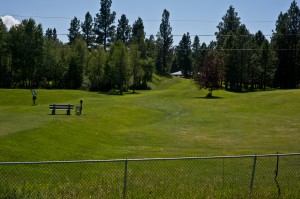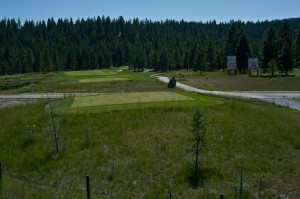THE FIELD OF DREAMS SYNDROME: By their very nature Municipal Governments, Regional Districts, Chambers of Commerce and similar local business organizations are optimistic and conservative in their approaches to planning for the future. The optimism is heart felt and needed in any attempt to move forward. The conservatism, however, is often based on assumptions and analysis that are history by the time they hit the discussion floor of these organizations. Over the past decade this combination of optimism and conservatism has led to an emphasis on tourism as a possible economic engine to offset the variability of the resource sector in the East Kootenays. The result is a plethora of tourist targeted developments. Numerous ski hill expansions, golf course constructions, hotel expansions and recreational real estate developments that have all been designed as added value “Fields of Dreams” to attract potential tourists. The philosophy seems to have
been “build it and they will come”. But have they? Over the past few years estimates of tourist traffic indicate a definite decline. Some anecdotal estimates place recent down turns as high or even higher than 30%. Added to the significant declines over recent years the idea that tourism is a growth industry is definitely dead. Even the most optimistic forecasts describe tourism activity as “flat” – a euphemism for “negative growth” or even, dare we say it, “decline”. Even by the most conservative estimates the truth of the matter is that tourism has been in steady decline for years. Noted in the Vancouver Sun, Saturday June 16th, 2012, “BC Ferries Traffic Sinks – hits lowest level in two decades contributing to $16.5 million loss” and “BC is recovering from a 20 year low in visits from Americans”.
Since the heady tourism days of the late 1990’s what do we have to show for the effort? An over supply in most tourist targeted projects (skiing, golfing, recreational real estate) and financially floundering development projects (Shadow Mountain, WildStone, Kookanoosca Lake Shore properties and on the horizon the Jumbo Pass Glacier development) and a tourism sector that continues to be sluggish. Why is that?
The reasons are many. Here are few. The financial crash of 2008 is right up there as the watershed moment that changed everything. That crash has been compounded by the ongoing European debt crisis, the high Canadian Dollar, negative affects of the HST, Peak Oil, the impacts of Global Warming, sales tax differentials with other jurisdictions and increased competition from both national and international tourist destinations. And it isn’t over yet. As the world financial centers roll from one crisis to another the economic uncertainty is likely to continue for many years. On the horizon is the impending implosion of the Chinese real estate boom. This will unleash another 2008 financial tsunami that will impact the whole globe. The Chinese money that has driven up real estate demand and prices in Western Canada will disappear and that, along with predicted higher mortgage rates, changes in mortgage rules and attempts to cool the “hot” market will lead to declines in local real estate values. The slide in values has already started. As Chinese economic activity slows so will the demand for Canadian resources with all the attending economic impacts.
Some, but not all, of the factors mentioned, could have been predicted or avoided. Locally the biggest problem has been timing. The sale of the Blackcomb / Whistler ski area was the penultimate signal that, despite the 2010 Winter Olympics, the Ski industry had peaked. Immediately prior to the games the shareholders knew that the glory days were over and it was time to take the money and run, and that they did.
Timing is always of the essence. The Cranbrook airport expansion is about 15 years too late. The intended influx of international flights to boost the local tourist industry was predicted on the success of earlier airport expansions projects south of the border. The infusion of public money encouraged Delta airlines to initiate international flights into Cranbrook that were later suspended due poor local and international response. Because the expansion was built with borrowed money this little bit of optimistic planning will continue to burden the local economy for years and yet, there is a bright side. The airport did need upgrading and proposed increases in tourist traffic was as good as an excuse as any to go ahead with this particular “field of dreams”. With an upgraded facility in place Cranbrook may now be able to assume its rightful place as a commercial business center. A local air carrier operating a much needed regular schedule between Cranbrook and Kelowna would be a helpful step in the right direction.
The fate of the airline industry and tourism traffic in general has been impacted by ‘Peak Oil’ (production output is being outpaced by demand – hence higher fuel prices). Simply put it means it costs more to get goods and people from one place to another. That cost is going to continue to rise.
The down turn in the economy and the negative impacts of the HST have decimated recreational property sales. But also at fault is some questionable market assumptions that probably identified baby boomers as potential buyers. The part of the equation that appears to be faulty is the lack of recognition that the targeted buyers are approaching retirement and one of their prime objectives would be a desire to downsize. A half million dollar property on a golf resort does not qualify as down sizing. Most women in that demographic would not look favourably on cleaning and maintaining a large, possibly an additional dwelling, that would be equivalent to a large domestic residence in the city. Similarly, large lake shore developments have the substance and appearance of suburban Calgary. Some where the ambience of cottage country got lost in the mix.
So where do we go from here? Denial or acceptance? With unpleasant news denial is always in the cards and there will be a perceived sense that the situation is not that bad. It’s just a hiccup and the economy will turn around and the good times are again just around the corner. Possible of course but unlikely. Wouldn’t it be better to hope for the best and plan for the worst. If things turn around that would be great but if things stagger on in the same fashion as the past few years a Plan B to diversify the local economy would be more than prudent. So folks, where is plan B?


